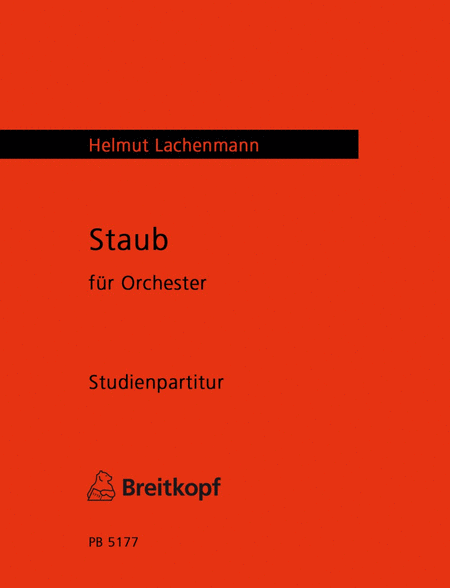Staub
Compositional "comment" on Beethoven's Symphony No. 9
Details
Description
SKU: BR.PB-5177-07
Compositional "comment" on Beethoven's Symphony No. 9. Composed by Helmut Lachenmann. Softbound. Partitur-Bibliothek (Score Library).World premiere: Saarbrucken, December 19, 1987
Music post-1945; New music (post-2000). Study Score. Composed 1985/87. 96 pages. Duration 23'. Breitkopf and Haertel #PB 5177-07. Published by Breitkopf and Haertel (BR.PB-5177-07).ISBN 9790004209172. 9 x 13 inches.
Lachenmanns compositional comment on Beethoven's Ninth Symphony achieved a certain notoriety even before it was completed. The Sudwestfunk Symphony Orchestra refused to play the work, commissioned by the broadcaster and known then as Prolog, at a festive anniversary concert in 1985. The waves have long subsided, and the orchestra, which has since produced a standard setting interpretation, has grown to appreciate the work.Staub (in German: dust, powder) product of desintegration of something that was created; cosmic matter; something settling down to form a sediment information of the time.In the situation when music is available at any time, my search for non-music which could be still experienced as music does not drive me forward to something unknown but lets me rather turn round. A discovery instead of having a breath of other planets air must rather stumble across the expressive forms surrounding us. It settles down or lands thereon, and in this way it transforms bits of shape (Beethovens 9th Symphony as a venerable stone-pit) into more or less recognizable components of an expanding and contracting perception field; surdlywhispered (dusty cantilena in largo, pulsation, bare juxtaposition of intervals are celebrated as emptied objects, thus becoming anew transparent for a listening that has overcome its philharmonic links without forgetting them.(Helmut Lachenmann)CD:Rundfunk-Sinfonie-Orchester Saarbrucken, cond. Myung Whun ChungCD BMG/RCA 74321 73518 2 (Musik in Deutschland 1950-2000)Bibliography:Hiekel, Jorn Peter: Der ,,moderne Beethoven. Reflexe auf sein Komponieren in der neuen Musik, in: Neue Zeitschrift fur Musik175 (2014), Heft 4, pp. 34-41.Mesquita, Marcos: Klangprojektion in die Zeit. Ein Weg zum Orchesterwerk Staub von Helmut Lachenmann (= sinefonia 13), Hofheim: wolke 2010.Nonnenmann, Rainer: Beethoven und Helmut Lachenmanns Staub fur Orchester (1985/87), fragmen, Heft 33, Saarbrucken: Pfau 2000.Toop, Richard: Concept and Context: A Historiographic Consideration of Lachenmanns Orchestral Works, in: Helmut Lachenmann Inward Beauty, hrsg. von Dan Albertson, Contemporary Music Review 23 (2004), Heft 3/4, pp. 125-144.Williams, Alistair: Helmut Lachenmann, Wolfgang Rihm and the Austro-German Tradition, in: Contemporary Music. Theoretical and Philosophical Percpestives, hrsg. von Max Paddison und Irene Deliege, Farnham (GB) und Burlington (USA): Ashgate 2010, pp. 361-370.
World premiere: Saarbrucken, December 19, 1987.

 Share
Share